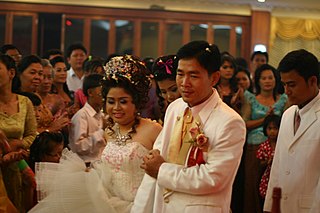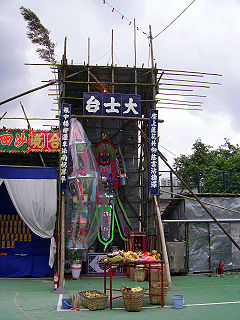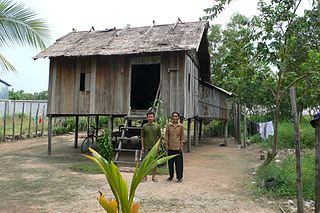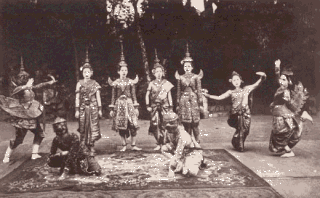 W
WThroughout Cambodia's long history, religion has been a major source of cultural inspiration. Over nearly three millennia, Cambodians have developed a unique Cambodian culture and belief system from the syncreticism of indigenous animistic beliefs and the Indian religions of Buddhism and Hinduism. Indian culture and civilization, including its languages and arts reached mainland Southeast Asia around the 1st century AD.
 W
WThe areca nut is the seed of the areca palm, which grows in much of the tropical Pacific, Southeast and South Asia, and parts of east Africa. It is commonly referred to as betel nut, not to be confused with betel leaves that are often used to wrap it. The term areca originated from the Malayalam word aṭaykka (അടയ്ക്ക) and dates back to the 16th century when Dutch and Portuguese sailors took the nut from India to Europe. Consumption has many harmful effects on health and is carcinogenic to humans. Various compounds present in the nut, including arecoline, contribute to histologic changes in the oral mucosa. It is known to be a major risk factor for cancers of the mouth and esophagus. As with chewing tobacco, its use is discouraged by preventive efforts. Consumption by hundreds of millions of people worldwide – mainly with southern and eastern Asian origins – has been described as a "neglected global public health emergency".
 W
WThe betel is a vine of the family Piperaceae, which includes pepper and kava. Betel leaf is mostly consumed in Asia, and elsewhere in the world by some Asian emigrants, as betel quid or in paan, with areca nut and/or tobacco.
 W
WThe history of Cambodian art stretches back centuries to ancient times, but the most famous period is undoubtedly the Khmer art of the Khmer Empire (802–1431), especially in the area around Angkor and the mainly 12th-century temple-complex of Angkor Wat, initially Hindu and subsequently Buddhist. After the collapse of the empire these and other sites were abandoned and overgrown, allowing much of the era's stone carving and architecture to survive to the present day. Traditional Cambodian arts and crafts include textiles, non-textile weaving, silversmithing, stone carving, lacquerware, ceramics, wat murals, and kite-making.
 W
WKhmer names are names used in, or originating in, Cambodia which usually consist of two elements including a patronymic, which serves as a common family name for siblings, followed by a given name. An example is singer Sinn Sisamouth, his surname is Sinn and his given name is Sisamouth. Traditionally, the Khmers do not have Western-style family names shared by multiple generations or entire families. Instead, Khmer children use their father's given name as their family name. Other Austroasiatic indigenous people groups within Cambodia have similar naming customs, while the Sino-Khmer and Viet-Khmer may follow Chinese and Vietnamese naming patterns, respectively. Chams in Cambodia may have either Khmer or Cham names or a combination of both. Cham name order is the reverse of the Khmer; the given name is followed by the father's given name.
 W
WChinthe is the Burmese word for 'lion'. The leograph of Chinthe is a highly stylized lion commonly depicted in Burmese iconography and architecture, especially as a pair of guardians flanking the entrances of Buddhist pagodas and kyaung. In contrast to popular foreign beliefs, the Chinthe is not a mythical creature but instead an entirely natural lion, although often associated with Buddho-Burmese myths. The leograph is featured prominently on most paper denominations of the Burmese kyat. A related creature, the Manussiha (Man-lion), is also commonly depicted in Myanmar.
 W
WCourtship, marriage, and divorce in Cambodia are important aspects of family life. Customs vary as between rural and urban areas, with many city dwellers being influenced by western ideas. The choice of a spouse is usually undertaken by the families of young men and women, sometimes with the help of a matchmaker. A man usually marries between the ages of nineteen and twenty-five and a girl between sixteen and twenty-two.
 W
WDance in Cambodia consists of three main categories: classical dance of the royal court, folk dance which portrays cultural traditions, and social dances performed in social gatherings.
 W
WThe history of Asian art includes a vast range of arts from various cultures, regions and religions across the continent of Asia. The major regions of Asia include Central, East, South, Southeast, and West Asia.
 W
WThe Ghost Festival, also known as the Zhongyuan Festival in Taoism and Yulanpen Festival in Buddhism. It is a traditional Taoist and Buddhist festival held in certain East Asian countries. According to the Chinese calendar, the Ghost Festival is on the 15th night of the seventh month.
 W
WHeritage Watch is a non-profit organization dedicated to saving Cambodia’s cultural legacy. Heritage Watch has been working since 2003 to raise awareness of looting and its consequences and to research the trade of illicit Cambodian antiquities.
 W
WA karaoke box is a type of karaoke establishment commonly found in East Asia, Southeast Asia, South Asia, the United States and Canada. It originated in Japan, and is now popular worldwide, particularly in Asia. Karaoke boxes consist of multiple rooms containing karaoke equipment, usually rented out for a period of time. A typical karaoke box establishment contains 10–20 such rooms, that can be themed so that each room has a different feeling or can be a traditional karaoke box, as well as have a main karaoke bar area in the front. Karaoke box establishments often sell beverages, and sometimes food but sometimes the establishment offers free refreshments. Many people of all ages enjoy karaoke as a pastime in Japan, as it still has a huge influence in the Japanese music scene and it is also a place that can attract tourists as well. One blogger, who is a fan of karaoke, writes "...to sing karaoke is to embrace the moment that your love of song transcends your love of self." While people do go to and enjoy karaoke boxes with family and friends, people also go by themselves and are able to enjoy the comfort of performing in the room by themselves. There is also a different style of karaoke, the traditional type where the patrons sing in front of everyone that is also still offered in popular entertainment areas, rather than the private boxes.
 W
WKhmer sculpture refers to the stone sculpture of the Khmer Empire, which ruled a territory based on modern Cambodia, but rather larger, from the 9th to the 13th century. The most celebrated examples are found in Angkor, which served as the seat of the empire.
 W
WMarriage in Cambodia is a social institution which structures Khmer society. The Khmer wedding, with its long history and rich symbolism, is also famous for its specific music, known as plheng kar.
 W
WMelodorum fruticosum, the white cheesewood, is a plant of the Annonaceae family native to South-East Asia. It is one of the two species considered the national flower of Cambodia. It is also the provincial flower of Sisaket Province, Thailand.
 W
WThe Ministry of Culture and Fine Arts is the government ministry with a mandate to promote, encourage and support the fine arts of Cambodia.
 W
WPaan is a preparation combining betel leaf with areca nut widely consumed throughout Southeast Asia, South Asia and East Asia. It is chewed for its stimulant effects. After chewing, it is either spat out or swallowed. Paan has many variations. Slaked lime (chuna) paste is commonly added to bind the leaves. Some preparations in the Indian subcontinent include katha paste or mukhwas to freshen the breath.
 W
WA pidan is a type of silk cloth used in Cambodian weddings, funerals, and Buddhist ceremonies as a canopy or tapestry. Pidan are often decorated with images of wats, nāgas, apsaras, scenes from the life of Buddha, Angkor Wat, animals, and plants.
 W
WRobam Sovann Maccha is a traditional Cambodian dance. It narrates the encounter of Hanuman and Sovann Maccha during the construction of the causeway to Lanka in Reamker, a Cambodian version of Indian epic Ramayana.
 W
WRomvong, Lamvong or Ramwong, pronounced [rām.wōŋ]), Rambung is a type of Southeast Asian dance where both females and males dance in a circle. It is a popular folk-dance in Cambodia, Laos, Malaysia and Thailand. It is a slow round dance continuously moving in a circular manner, and incorporates graceful hand movements and simple footwork. Both men and women participate in the same circle.
 W
WRural Khmer houses are a traditional house types of the Khmer people.
 W
WSampeah is a Cambodian greeting or a way of showing respect. It is very similar to the Thai wai. Both Sampeah and Thai wai are based on the Indian Añjali Mudrā used in namasté. Pranāma or Namaste, the part of ancient Indian culture has propagated to southeast Asia, which was part of indosphere of greater India, through the spread of Hinduism and Buddhism from India.
 W
WSphaerocoryne affinis is a species of flowering plant in the soursop family, Annonaceae. The fragrant flowers of Sphaerocoryne affinis are highly regarded in Cambodia and Thailand.
 W
WA spirit house is a shrine to the protective spirit of a place that is found in the Southeast Asian countries of Burma, Cambodia, Laos, Thailand, Malaysia, Indonesia, Vietnam and the Philippines. The spirit house is normally in the form of small roofed structure, and is mounted on a pillar or on a dais. They can range in size from small platforms to houses large enough for people to enter. Spirit houses are intended to provide a shelter for spirits that could cause problems for the people if not appeased. The shrines often include images or carved statues of people and animals. Votive offerings are left at the house to propitiate the spirits. More elaborate installations include an altar for this purpose.
 W
WTheatre of Cambodia known as Lakhon is composed of many different genres. There are three main categories: classical, folk, and modern. Many forms of theatre in Cambodia incorporates dance movement into performances and are referred to as dance dramas.
 W
WYantra tattooing or Sak Yant is a form of tattooing using Indian yantra designs. It consists of sacred geometrical, animal and deity designs accompanied by Pali phrases that are said to offer power, protection, fortune, charisma and other benefits for the bearer.Sak Yant designs originated from the Khmer Empire
 W
WYeay Mao or Lok Yeay Mao is an ancient mythical heroine and a neak ta divinity in the local popular form of Buddhism and Brahmanism in Cambodia. She is venerated mainly is in the coastal provinces of the country, especially along the road from Phnom Penh to the sea port of Sihanoukville, as well as in Kampot and Kep. At the Bokor Mountain in Kampot there is a 29 meters tall monument to Yeay Mao inaugurated in 2012, while there is a young version of Yeay Mao in the Kep Beach called Beautiful Lady (ស្រីស្អាត) or Sela waits for her husband (សិលាចាំប្តី), but that belongs to the legend of Mao looking to the west for her lost husband. She is considered the protector of travelers and hunters. Drivers still stop at her shrine along National Road 4 near Phnom Pech Nil to pay their respects and wash their cars with water from the stream nearby, as well as the monument at Bokor.